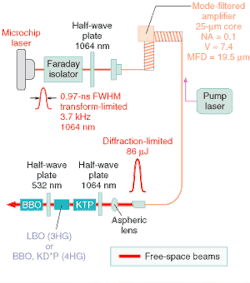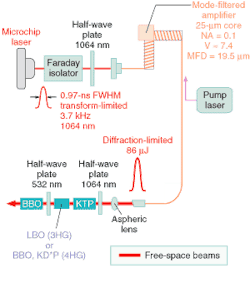UV light comes from infrared fiber source
Building upon previous successful efforts to increase the power available from pulsed fiber sources with diffraction-limited beam quality, researchers at Sandia National Laboratories (Livermore, CA, and Albuquerque, NM) and the Naval Research Laboratory (Washington, D.C.) have obtained unusually high frequency-conversion efficiencies using critically phase-matched nonlinear crystals in a relatively simple optical arrangement. Starting with 320 mW of average power at 1064 nm, the research team obtained 160 mW at 532 nm, 38 mW at 355 nm, 69 mW at 266 nm, and 18 mW at 213 nm.1
"Such high conversion efficiencies could also be achieved by using noncritically phase-matched (temperature-tuned) or quasi-phase-matched crystals or by housing the crystals in resonant cavities, but these approaches increase the complexity and limit the tuning range of the system," said Dahv Kliner at Sandia National Laboratories in Livermore. "In contrast, the ability to use ambient temperature, critically phase-matched (angle-tuned) crystals, single-pass mixing, and a simple optical setup (one lens to focus the amplifier output) provided a compact, rugged approach to generation of radiation throughout the visible and ultraviolet spectral regions," he said.
Compact and efficient sources of visible and ultraviolet (UV) radiation are required for a wide variety of applications ranging from chemical sensing and materials-processing tasks to writing of Bragg fiber gratings, according to Kliner. Additional characteristics such as continuous tunability, broad wavelength coverage, narrow linewidth, high peak or average power, and high beam quality can also be required.
The researchers obtained high nonlinear conversion efficiencies because of the high peak power and diffraction-limited beam quality provided by their mode-filtered fiber amplifier (see Laser Focus World, June 2002, p. 42). In the current work, the fiber amplifier was seeded with the 1064-nm output of a passively Q-switched Nd:YAG microchip laser pumped with an 808-nm diode laser. The nonlinear crystals were positioned near the beam waist and were angle tuned to maximize the conversion efficiency (see figure).
The second harmonic (532 nm) of 1064-nm input was generated using Type II phase matching in a potassium titanyl phosphate (KTP) crystal. The fourth harmonic (266 nm) was generated by Type I doubling of the 532-nm light in either a beta barium borate (BBO) or a potassium dihydrogen phosphate crystal. The third harmonic (355 nm) was generated by Type I mixing of the 532-nm radiation with the residual 1064-nm radiation of the same polarization using a lithium triborate crystal. The fifth harmonic (213 nm) was generated by Type I mixing of the 532- and 355-nm radiation in BBO. Bold lines indicate free-space beams.
The experimental results were compared with calculations based on a software program that was created by a member of the research team and is available online for free download. "The program takes into account the spatial and temporal profiles of the beam, the beam divergence, diffraction, losses with in the crystals," Kliner said. They used the software to simulate their experimental conditions and observed nearly perfect agreement with experiment, with no adjustable parameters. "It was important for us to do that because there are other wavelength regions that we want to access," he said. "So showing that these calculations can be so accurate is important for extrapolating to other wavelength regions or other frequency conversions schemes, as well as other laser power levels and other nonlinear crystals."
In the initial experiment, the fiber amplifier was operated at a peak power of about 80 kW, but the capacity is in excess of 300 kW. "Running at higher powers and further optimization of nonlinear conversion schemes should allow visible and UV powers to increase into the one-watt range and beyond," Kliner said.
REFERENCE
- D. A. V. Kliner et al., Optics Comm. 210, 393 (2002).

